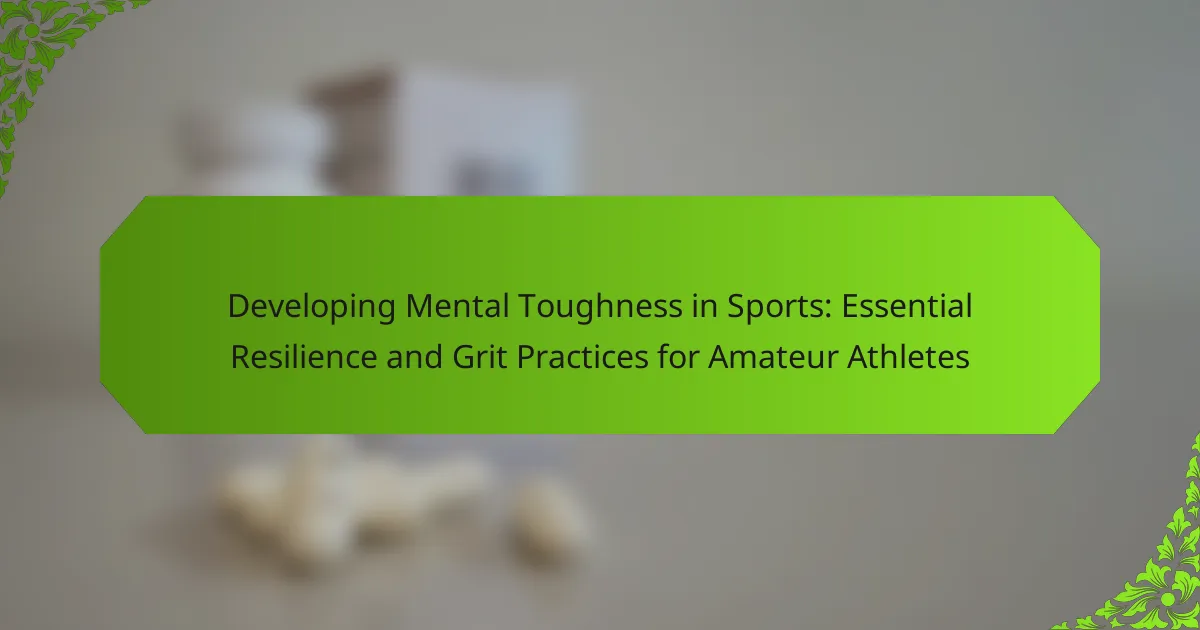Building mental toughness is crucial for athletes aiming to overcome setbacks and achieve their goals. Grit practices foster resilience, discipline, and a growth mindset. They include setting specific goals, embracing failure as a learning opportunity, and developing consistent training routines. By avoiding common mistakes and focusing on continuous improvement, athletes can enhance their performance and personal growth.

What are Grit Practices and Why are They Important for Amateur Athletes?
Grit practices are essential for amateur athletes as they foster mental toughness, resilience, and goal achievement. These practices help athletes overcome setbacks and maintain focus on their objectives. By developing grit, athletes enhance their ability to persist through challenges, leading to improved performance and personal growth. Research shows that athletes with high levels of grit are more likely to succeed in their sports, as they are better equipped to handle adversity and stay committed to their training.
How does mental toughness contribute to athletic performance?
Mental toughness significantly enhances athletic performance by enabling athletes to maintain focus, resilience, and determination during challenges. This grit manifests through consistent training, positive self-talk, and visualization techniques. As a result, athletes with high mental toughness are better equipped to overcome setbacks and achieve their goals. Research indicates that mental toughness correlates with improved performance metrics, such as endurance and competitive success. Developing this attribute can lead to sustained motivation and a more robust response to stressors in competitive environments.
What role does resilience play in overcoming setbacks?
Resilience is crucial for athletes to overcome setbacks. It enables them to adapt, maintain focus, and persist despite challenges. Resilient athletes view failures as learning opportunities, cultivating grit that drives them toward their goals. This mental toughness enhances performance and fosters a growth mindset, ultimately leading to greater achievements in their sport.
What are common setbacks faced by amateur athletes?
Amateur athletes commonly face setbacks such as injuries, lack of resources, and mental barriers. These challenges can hinder performance and progress. Injuries may lead to extended recovery times, while limited access to coaching or training facilities can restrict skill development. Mental barriers, including self-doubt and anxiety, can significantly impact an athlete’s confidence and motivation. Addressing these setbacks through grit practices is essential for building mental toughness and achieving long-term goals.

What are the Universal Attributes of Grit Practices?
Grit practices for athletes universally emphasize resilience, discipline, and goal-setting. These attributes foster mental toughness and enable athletes to overcome setbacks. Key practices include consistent training, reflection on failures, and maintaining a growth mindset. Athletes who engage in these practices often report improved performance and greater achievement of their goals.
How can goal-setting enhance resilience?
Goal-setting enhances resilience by providing clear objectives, fostering motivation, and promoting a growth mindset. Athletes who set specific, measurable goals can better navigate challenges and setbacks. This practice builds mental toughness, enabling them to persist despite difficulties. Research indicates that goal-setting can improve performance by up to 25%, demonstrating its significant impact on resilience. Additionally, the process of setting and achieving goals reinforces self-efficacy, further strengthening an athlete’s ability to cope with adversity.
What techniques foster a growth mindset among athletes?
Developing a growth mindset among athletes involves techniques that enhance resilience and adaptability. Key practices include setting specific, challenging goals that encourage effort and persistence, fostering a culture of feedback where athletes learn from mistakes, and promoting self-reflection to assess progress and areas for improvement. Additionally, visualization techniques can help athletes mentally prepare for challenges, reinforcing belief in their abilities. Engaging in team-building activities also cultivates a supportive environment, which is essential for developing mental toughness.
What are effective visualization strategies for building grit?
Visualization strategies like goal-setting, mental imagery, and self-talk effectively build grit in athletes. These techniques enhance focus, resilience, and motivation, crucial for overcoming setbacks. Goal-setting involves breaking down objectives into manageable steps, fostering a sense of achievement. Mental imagery allows athletes to visualize success, reinforcing confidence and commitment. Self-talk helps maintain a positive mindset, enabling athletes to push through challenges. Implementing these strategies consistently can lead to improved mental toughness and goal achievement.

What Unique Attributes Distinguish Successful Athletes?
Successful athletes exhibit unique attributes such as resilience, discipline, and adaptability. These traits enable them to overcome setbacks and maintain focus on their goals. Resilience allows athletes to bounce back from failures, while discipline ensures consistent training and adherence to routines. Adaptability helps them adjust strategies in response to changing circumstances. Together, these attributes form a robust foundation for achieving success in competitive sports.
How do role models influence grit development?
Role models significantly enhance grit development by providing inspiration and practical strategies. Athletes often emulate the behaviors and mindsets of successful figures, which fosters resilience. Observing how role models navigate challenges teaches athletes to persist despite setbacks. This modeling effect creates a framework for developing mental toughness, essential for achieving long-term goals.
What specific training methods enhance mental toughness?
Specific training methods that enhance mental toughness include visualization, goal setting, and resilience training. Visualization helps athletes mentally rehearse scenarios, improving focus and confidence. Goal setting provides clear objectives, fostering motivation and a sense of achievement. Resilience training equips athletes to handle adversity and setbacks, reinforcing their mental fortitude. These methods collectively build grit, enabling athletes to overcome challenges and reach their goals.

What are the Rare Attributes of Grit Practices in Sports?
Grit practices in sports often include unique attributes that enhance mental resilience. Rare attributes of these practices involve specific strategies such as visualization techniques, which help athletes mentally rehearse success scenarios. Another rare attribute is the incorporation of failure analysis, where athletes dissect setbacks to extract valuable lessons. Additionally, fostering a growth mindset is a rare but powerful attribute, enabling athletes to embrace challenges and persist despite difficulties. These attributes collectively contribute to a holistic approach to building grit in athletes.
How can athletes leverage failure for growth?
Athletes can leverage failure for growth by embracing setbacks as learning opportunities. This mindset fosters resilience and enhances mental toughness, essential attributes for achieving long-term goals. By analyzing failures, athletes identify areas for improvement and develop grit through consistent practice. This unique approach transforms challenges into stepping stones, ultimately leading to greater success in their sport.
What unconventional strategies can boost resilience?
Unconventional strategies to boost resilience include embracing failure, practicing mindfulness, and fostering a growth mindset. Embracing failure allows athletes to view setbacks as opportunities for growth, enhancing mental toughness. Mindfulness practices, such as meditation, improve focus and emotional regulation, essential for overcoming challenges. Finally, a growth mindset encourages athletes to see their abilities as improvable, leading to persistent effort and goal achievement. These approaches collectively enhance grit and resilience in athletes.

How can Amateur Athletes Implement Grit Practices in Daily Training?
Amateur athletes can implement grit practices by setting specific, challenging goals, maintaining a consistent training schedule, and embracing discomfort. These strategies build resilience and mental toughness.
1. Set SMART goals: Specific, Measurable, Achievable, Relevant, Time-bound objectives enhance focus and motivation.
2. Embrace failure: View setbacks as learning opportunities to develop perseverance.
3. Cultivate a growth mindset: Believe in the ability to improve through effort and practice.
4. Develop routines: Establish daily habits that reinforce commitment and discipline.
5. Seek feedback: Regularly evaluate performance to identify areas for improvement.
6. Reflect on progress: Keep a journal to track achievements and setbacks, fostering self-awareness.
What daily routines can enhance mental toughness?
Daily routines that enhance mental toughness include consistent goal-setting, regular self-reflection, and practicing resilience through challenges. Engaging in physical training builds discipline, while mindfulness practices improve focus. Incorporating these elements fosters grit, enabling athletes to overcome setbacks and achieve their objectives.
What are the steps to create a personal grit training plan?
To create a personal grit training plan, follow these steps: define your goals, assess your current mental toughness, identify challenges, develop strategies to overcome setbacks, and track your progress.
1. Define your goals: Establish clear, measurable objectives that align with your aspirations.
2. Assess your current mental toughness: Evaluate your resilience in facing challenges and setbacks.
3. Identify challenges: Recognize specific obstacles that hinder your performance and mental strength.
4. Develop strategies: Create actionable plans to enhance grit, such as visualization techniques or positive self-talk.
5. Track your progress: Regularly review your achievements and setbacks to adjust your training plan accordingly.
How can athletes track their progress in building resilience?
Athletes can track their progress in building resilience through consistent self-assessment and goal-setting. Regularly reflecting on experiences and outcomes helps identify strengths and areas for improvement.
Journaling is a practical tool for documenting feelings and responses to challenges. This practice allows athletes to recognize patterns and adapt strategies.
Utilizing performance metrics, such as recovery time and stress levels, provides quantitative data to monitor progress. Setting specific, measurable goals encourages accountability and motivation.
Engaging in feedback sessions with coaches or peers fosters an external perspective on resilience development. This collaborative approach enhances self-awareness and promotes growth.

What Common Mistakes Should Athletes Avoid in Grit Practices?
Athletes should avoid common mistakes in grit practices to enhance mental toughness and goal achievement. Key mistakes include neglecting recovery, lacking goal specificity, and ignoring emotional responses.
1. Neglecting Recovery: Athletes often push through fatigue without allowing adequate rest, which can hinder performance and mental resilience.
2. Lacking Goal Specificity: Setting vague goals leads to confusion and lack of direction; athletes should define clear, measurable objectives.
3. Ignoring Emotional Responses: Dismissing feelings of frustration or doubt can prevent athletes from addressing underlying issues and developing grit.
4. Overemphasizing Results: Focusing solely on outcomes can create pressure; athletes should value the learning process and incremental improvements.
5. Failing to Seek Feedback: Avoiding constructive criticism limits growth; athletes should actively seek input to refine their grit practices.
6. Comparing to Others: Athletes should focus on personal progress rather than comparing themselves to peers, which can undermine motivation.
What are the pitfalls of negative self-talk?
Negative self-talk can undermine mental toughness and hinder goal achievement for athletes. It leads to decreased motivation, increased anxiety, and a distorted self-image. Athletes may experience performance anxiety, which can result in underperformance during competitions. Additionally, negative self-talk can create a cycle of self-doubt, making it challenging to overcome setbacks. Developing grit practices, such as positive affirmations and resilience training, can counteract these pitfalls and foster a more constructive mindset.
How can overtraining affect mental toughness?
Overtraining can significantly diminish mental toughness by causing fatigue, anxiety, and decreased motivation. Athletes may experience a drop in performance and increased susceptibility to stress. This decline in mental resilience can hinder goal achievement and recovery from setbacks. Recognizing the signs of overtraining is crucial for maintaining grit and sustaining long-term athletic success.

What Best Practices Can Athletes Adopt for Lasting Grit?
Athletes can adopt practices that foster grit by focusing on resilience, goal-setting, and continuous learning. Developing a growth mindset is crucial; it encourages viewing challenges as opportunities rather than obstacles. Regularly setting specific, measurable goals helps maintain motivation and direction.
Building a support network of coaches and peers provides emotional resilience during setbacks. Engaging in reflective practices, such as journaling, can enhance self-awareness and facilitate learning from experiences. Lastly, maintaining physical fitness through consistent training builds not only physical strength but also mental toughness, reinforcing the ability to persevere.
What expert insights can help enhance resilience and grit?
Expert insights for enhancing resilience and grit include setting clear goals, embracing challenges, and maintaining a positive mindset. Athletes can benefit from visualization techniques that reinforce mental toughness. Regular reflection on past setbacks can foster growth and adaptability. Engaging in consistent practice builds habits that strengthen perseverance.
How can athletes cultivate a supportive community for growth?
Athletes can cultivate a supportive community for growth by fostering connections, sharing experiences, and encouraging accountability. Building relationships with teammates and mentors enhances resilience and motivation. Active participation in group training sessions promotes camaraderie and shared learning. Establishing open communication channels allows athletes to express challenges and celebrate successes, reinforcing a culture of support. Engaging in community events or workshops can further strengthen these bonds, creating a network that is vital for personal and athletic development.



